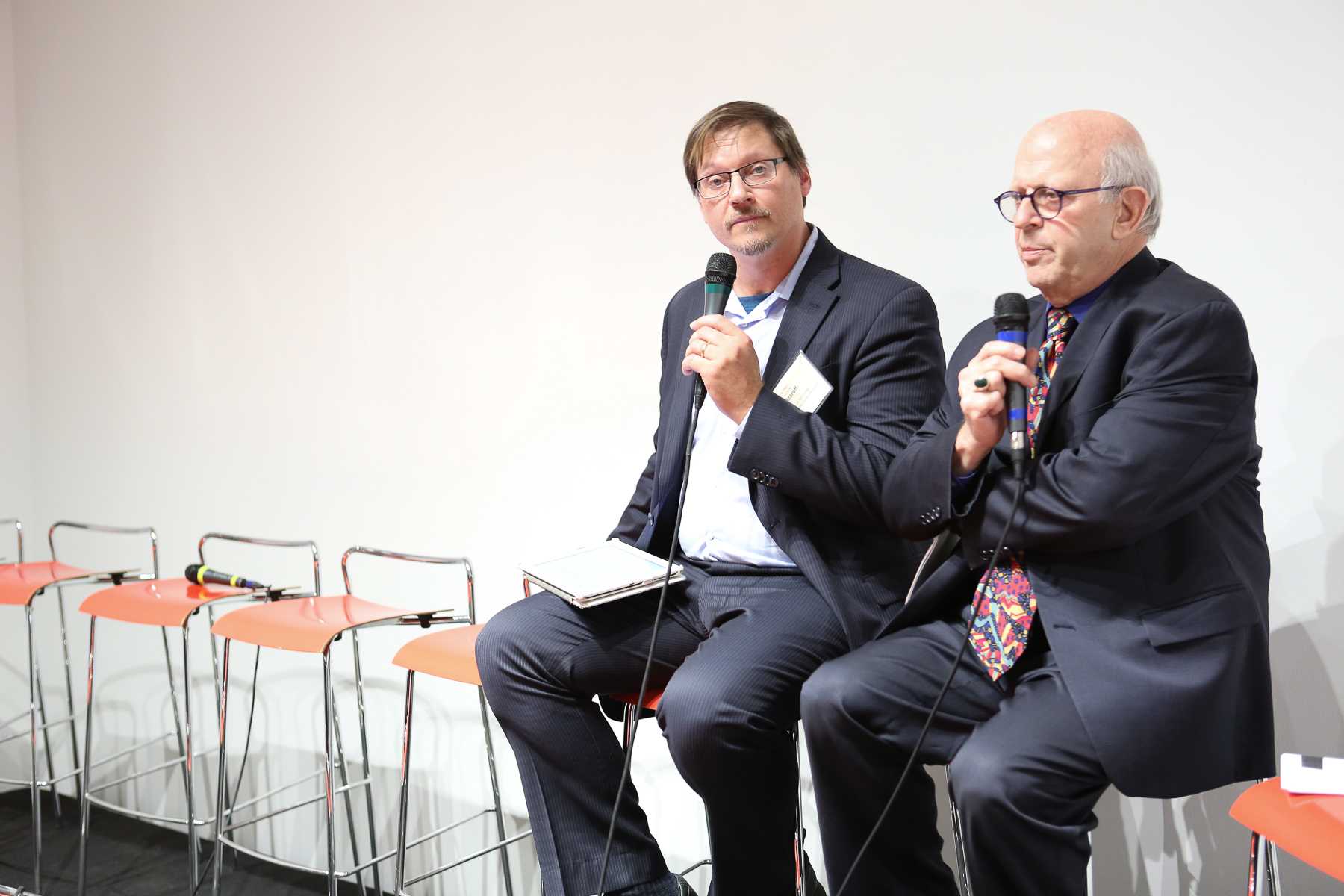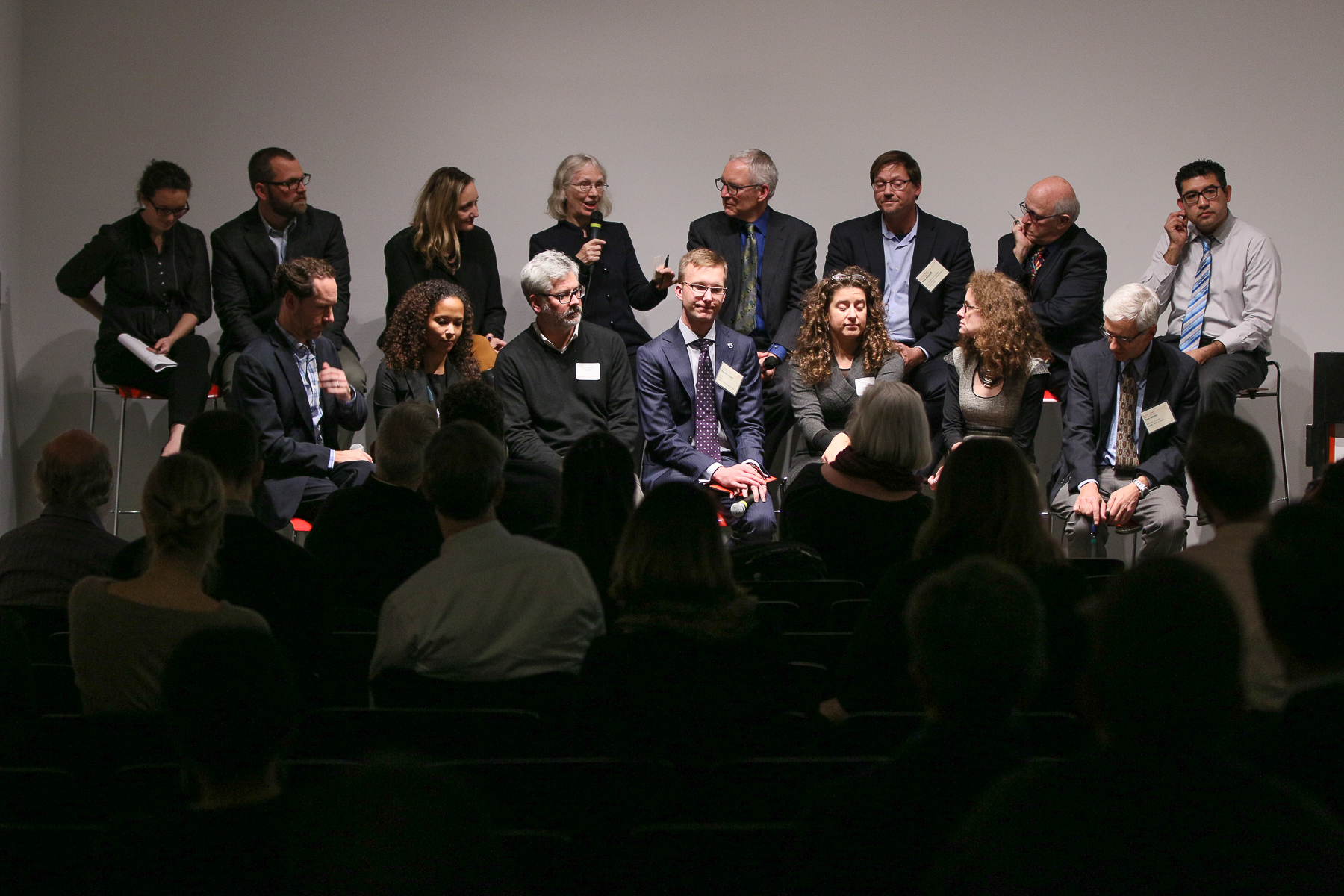by: Bill Millard
Now that every rational person and entity from Bill McKibben and Al Gore to ExxonMobil and the Pentagon accepts the reality of anthropogenic climate change (at least internally, regardless of public statements), exploring its effects as a “threat multiplier” has become a broad-based professional priority. Having helped focus the architectural community’s attention on flood hazards shortly before Superstorm Sandy, then led wide-ranging efforts toward both recovery from that event and resilience against future disasters, the AIANY Design for Risk and Reconstruction (DfRR) committee has earned considerable authority on the built environment’s ability to handle catastrophic events. The risks associated with more gradual effects can be just as severe. DfRR has, accordingly, extended its attention to design, investment, and public policy strategies that respond to deadlier and more frequent heat waves.
The “Extreme Heat” conference marks the recognition of hyperthermal design as a distinct body of knowledge, with practical implications for building and landscape forms, health protection, and infrastructure planning. DfRR will follow the conference with a larger report presenting the findings and aiming at advancing the field. Introducing the daylong, 32-speaker event on 11.12.15, DfRR Founding Co-chair Lance Jay Brown, FAIA, cited Gore’s memorable (though herpetologically implausible) metaphor of a frog quickly leaping away when exposed to boiling water, but remaining still and vulnerable when placed in cold water brought to a slower boil, to illustrate the human propensity to ignore incremental processes. As knowledge about global thermal processes increases, climatologists expect heat waves to strike cities particularly hard, and for some entire regions (notably, in recent headlines, the Persian Gulf area) to approach uninhabitability. Some buildings exacerbate the urban heat-island effect, often at great cost to human life. Medical historian Richard Keller, author of Fatal Isolation (University of Chicago, 2015), alarmed the audience with the death toll from the 2003 European heat wave in France alone, some 15,000 people, many of whom were low-income elderly Parisians trapped in the small, underventilated upper chambers of classic Haussmannian buildings. Their design reflects what Keller termed a “new geography of inequality on the vertical plane.” Other structures can help mitigate heat risks on local and metropolitan levels through wind-enhancing forms, green or cool (high-albedo) roofs and pavement, water management, local cooling centers, and other strategies. Social bonds and habits can reduce the abandonment that increases heat vulnerability, noted Keller, sociologist Sabrina McCormick, and others. In that respect, neighborhood-scale built environments conducive to human contact are adaptive and protective as well. Though increasing density minimizes most environmental problems, noted Georgia Tech’s Brian Stone, the heat-island effect is the one exception to that pattern, creating a need for heat-management planning that matches greening and cooling strategies to neighborhood-scale conditions.
Hunter Jones of the National Oceanic and Atmospheric Administration (NOAA) laid a factual foundation for the discussions, describing what’s known, unknown, and potentially knowable from climate observations globally and nationally. Temperatures do not rise uniformly: northern latitudes, where people and buildings are less adjusted to extreme heat, are seeing the most drastic warming. The heat-island effect means that the hardscape of Manhattan is often about 10°F warmer than nearby forested areas in Central Park. Current predictive models allow skillful temperature estimates a week or two into the future, losing accuracy in the medium subseasonal scale, then becoming more accurate in assessing longer-range trends; if predictions in that medium range can improve, emergency management will likewise become more effective, since planners need to make decisions on multiple time scales. A new National Integrated Heat Health Information System, announced by the White House last June with a workshop in Chicago in July (the 20th anniversary of a deadly heat wave), will integrate planning, preparedness, research, and early-warning communication in this area.
A condensed and practical overview by emergency physician Elan Levy, MD, provided additional knowledge about what happens biologically when the body’s regulatory mechanisms – remarkably resilient to cold, Dr. Levy noted, but susceptible to life-threatening multisystemic breakdowns when heat cannot be dissipated – encounter dangerous heat, particularly a core temperature above 104°F. The distinction between exertional and nonexertional hyperthermia is important: the heat-stressed athlete whose evaporation mechanism is overwhelmed by heat and humidity can still sweat; nonexertional heat stroke typically affects children or the elderly Heat waves can cause massive influxes of such patients into emergency departments, creating scenarios where hospitals need to discharge non-critical patients; New York State health facilities’ preparations now include an electronic patient-tracking system, Evacuation of Facilities in Disaster Systems (E-FINDS), a chaos-reducing measure adopted after Superstorm Sandy.
References by Jeffrey Raven, FAIA, and others to Stone’s term “adaptive mitigation” acknowledge that while prevention of greenhouse-gas effects has become impossible, design interventions that address the heat-island effect can help put brakes on the rising mercury and aid people’s resilience as it rises; it’s helpful to view adaptation and mitigation, Raven noted, as mutually synergizing rather than bifurcating concepts. A panoply of strategies appeared in the presentations, from cultural practices (the siesta, the Philadelphia-style block-captain program, incentives for more efficient transportation modes) to biophilic and biomimetic designs, both incorporating natural elements into urban spaces and learning from nature’s adaptations; seed banking, as the NYC Parks Department is doing (and its spokesman Ed Toth recommends replicating on a national scale) to maintain genetic diversity of regionally appropriate species and conserve ecosystems; familiar green-design approaches to shading, thermal mass, and ventilation, along with newer thermal systems embedding capillary tubes in walls; and high-performance materials such as porous concretes, thermoplastic window films, and heat-storing phase-change materials like paraffin that melt under daytime heat and recrystallize at night. Grimshaw’s Andrew Whalley described a series of particularly striking projects that employ water in creative ways, as a façade coolant that removes heat while admitting sunlight (the British Pavilion for Expo ‘92 in Seville), a distillation-irrigation system for growing food under extreme conditions (the Seawater Greenhouse in Las Palmas de Gran Canaria), or a dew-harvesting canopy of hydrophobic micromesh (a large Middle Eastern project he wasn’t at liberty to identify yet).
Beyond each encouraging project, constructive idea, or alarming observation, two unifying and recurrent themes arose. First, there is no single magic-bullet solution to heat hazards; all available tools need to be combined as climate change creates a long-range “all hands on deck” condition. The United Nations Climate Change Conference a.k.a. Conference of the Parties (COP21), soon to begin in Paris, will bring critically important attention to the situation. And on a philosophical level, as Anna Dyson emphasized, in discussions of climate change or solar heat gain, it is beneficial to view solar heat more as an asset than a threat. The sun’s power, which Wolfgang Rieder noted “we barely use” (only 0.15% by his calculations, echoing Buckminster Fuller’s observations in Critical Path on solar energy and scarcity), comes to us free, without the counterproductive and unsustainable effects of the paleotechnic era’s finite, filthy substitutes. “We should consider ourselves lucky so much solar energy is coming into our environment,” Dyson commented. “We just haven’t figured out how to make it valuable. Natural systems don’t need to figure out what to do with it as we do. From the engineering side, we need to redistribute heat in a viable way.”
Event: Extreme Heat: Hot Cities – Adapting to a Hotter World
Location: Center for Architecture, 11.12.15
Speakers: Illya Azaroff, AIA, Associate Professor in Architectural Technology, Founder, +LAB architect PLLC, Founding Co-Chair, DfRR; Chris Benedict, Principal, Architecture & Energy Ltd.; Reginald Blake, PhD, Assistant Professor, Biological Sciences, CUNY – NYCCT; Pippa Brashear, Director of Planning and Resilience, SCAPE Landscape Architecture; Lance Jay Brown, FAIA, DPACSA CCNY, Founding Co-Chair, DfRR; Kizzy Charles-Guzman, New York City Program Policy Director, The Nature Conservancy; Anna Dyson, Professor and CASE Director, School of Architecture at Rensselaer; Richard Keller, PhD, Professor, University of Wisconsin; Author, Fatal Isolation; Laurie Kerr, FAIA, LEED AP, Director of Policy, Urban Green Council; Eric Klinenberg, PhD, Author, Heat Wave; Professor of Sociology and Director, Institute for Public Knowledge, NYU; Elan Levy, MD, Attending Physician, Emergency Department, Lenox Hill Hospital/Lenox Health Greenwich Village, North Shore-LIJ Health System; Tom Matte, Assistant Commissioner for Environmental Surveillance and Policy, NYC Department of Health and Mental Hygiene; Emily Nobel Maxwell, NYC Program Director for Urban Sustainability, The Nature Conservancy; Sabrina McCormick, PhD, Associate Professor of Sociology, George Washington University; Amy Patel, AIA, LEED AP BD+C, Commercial Key Account Manager, The BASF Center for Building Excellence; Jeffrey Raven, FAIA, Associate Professor and Director of the MS, Architecture, Urban and Regional Design, NYIT; Wolfgang Rieder, CEO and Founder, fibreC; Cynthia Rosenzweig, PhD, Senior Research Scientist, Climate Impacts Group, NASA Goddard Institute for Space Studies; James Russell, FAIA, Architecture Critic and Journalist; Porie Saikia-Eapen, AIA, FCIOB, Chartered CM, Director, Sustainability & Environmental Compliance, MTA HQ; Kurt Shickman, Executive Director, Global Cool Cities Alliance; Anne Marie Sowder, Assistant Professor in Construction Management – Civil Engineering, CUNY – NYCCT, DfRR Extreme Heat Program Chair; Brian Stone, PhD, Associate Professor and PhD Program Director, Georgia Tech University School of City & Regional Planning; Ed Toth, Director, Greenbelt Native Plant Center Seed Collection & Banking Program, NYC Parks; Melissa Umberger, Hazard Mitigation Project Manager, NYC Emergency Management; Jason Vollen, PhD, AIA, Principal, High Performance Building Group, AECOM; Neil Weisenfeld, Director of Strategic Planning, Con Edison of New York; Andrew Whalley, AIA, RIBA, Deputy Chairman Grimshaw Architects; Rae Zimmerman, PhD, Professor of Planning and Public Administration, NYU
Organizers: AIANY Design for Risk and Reconstruction (DfRR) Committee and New York City College of Technology, in partnership with AIANY Building Enclosure Council, AIANY Building Codes Committee, AIANY Committee on the Environment (COTE), AIANY Design for Aging Committee, AIANY Health Facilities Committee, AIANY Housing Committee, AIANY Planning and Urban Design Committee, AIANY Transportation and Infrastructure Committee, American Society of Landscape Architects – New York Chapter (ASLA-NY), CUNY- New York City College of Technology, NYC Department of Health and Mental Hygiene, NYC Mayor’s Office of Recovery & Resiliency, NYC Office of Emergency Management, NYC Department of Parks and Recreation, NYC Urban Heat Island Working Group, The Rockefeller Foundation, The Nature Conservancy, and Urban Green Council
Sponsors: Autodesk (benefactor), BASF, Big Ass Fans, and Pizzarotti-IBC (patrons)









